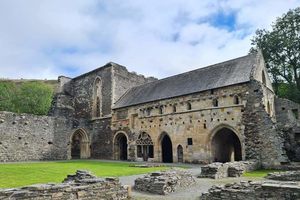Valle Crucis Abbey in Llantysilio, Wales

Valle Crucis was founded by Prince Madog ap Gruffydd and the “White Monks” of the Cistercian order in 1201. The name Valley Crucis derives from Latin and means Valley of the Cross. The name is thought to refer to the nearby 9th-century Pillar of Eliseg.
The Cistercians were known for constructing their monasteries in remote locations, which allowed them to combine an austere religious life with the farming duties needed to ensure they were self-sufficient. Like other Cistercian settlements, Valle Crucis accommodated both choir monks, who spent their time in prayer and contemplation, and the lay brothers, who undertook the more mundane duties. During its early years, the abbey was successfully self-sufficient.
Although Valle Crucis began its life in austerity, the abbey was later celebrated for its hospitality. There are various stories of feasts being served where ale flowed like a river. In fact, in Wales, only Tintern Abbey was considered to be wealthier.
The abbey suffered serious damages during a fire in 1236, but managed to survive. Traces of the fire are still visible on the lower stonework of the church.
Valle Crucis was dissolved in 1537 after the Dissolution of the Monasteries. The buildings rapidly fell into disrepair. During the late 16th-century, the eastern range was converted into a house, before it also fell into ruin. Many of the structures were later repurposed to accommodate a farm.
Valle Crucis is unusual because it contains the only surviving monastic fishpond in Wales tucked away behind the ruins.





